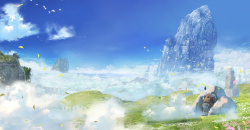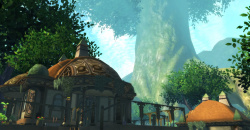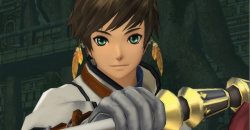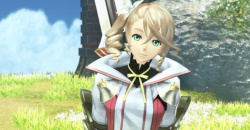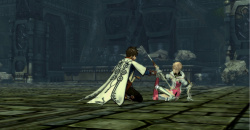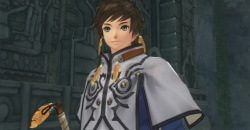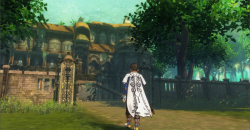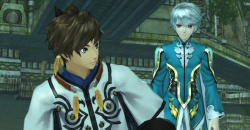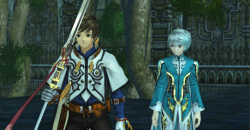Tales of Zestiria tells the story of the Shepherds, people with special abilities that allow them to communicate with the supernatural race of beings known as the Seraphim, protecting humanity from the powers of darkness. Shepherds have always appeared in times of great need to fight back the encroaching chaos and shield lesser mortals from its devastating effects. However, no Shepherds have arisen since peace last came to the world, and for most people they are little more than a legend. They appear to have disappeared from the face of the earth. Or have they?
The current plot begins in Elysia, home of the Seraphim. You meet Sorey and Mikleo – who, judging by the way they act, could be brothers – as they investigate some ruins near their village for traces left by the Shepherds. Near the end of their little outing, these two bumbling heroes fall into a hole in the ground, finding themselves in the middle of an underground tunnel system. They begin exploring the caves, and soon come across an unconscious girl who starts to awaken the moment they find her. After some back and forth, the two boys decide to take the exhausted young maiden – who has not yet revealed her name – back with them to the village, where she will be able to regain her strength.
Upon arriving in the village, Sorey and Mikleo inform their grandfather of the unannounced visitor, and he is anything but pleased. In the conversation that follows, you find out that the Seraphim don’t like it when humans enter their village. Sorey is a human boy, but he has been raised by Mikleo’s grandfather to be a part of the community there, meaning that the girl from the cave is his first contact with another human being. Nevertheless, the grandfather insists that this outsider will have to leave the village the very next day.
Sorey plans to accompany the girl on her journey back home to the town of Ladylake, but as he is preparing for the trip, she reveals her true motives to him. She explains that chaos has erupted once again in the world of men in the form of a plague of evil beings known as the Hellion, and that the people are struggling with crop failure, famine, and sickness on a massive scale. All hope appears to be lost, and the only thing that can bring humanity back from the brink of destruction is the return of the long-forgotten Shepherds. In the course of the long adventure, you’ll discover what all this has to do with Sorey, and whether there really are Shepherds out there who can stem the tide of the Hellion.
Gameplay Right after the intro sequence, they give you a short overview of the controls, which makes it a lot easier to just start playing without having to figure out anything as basic as the controller layout. And of course, you can always go back to the options menu to check it if you need to. Before you set off on your adventure, you can choose from a variety of difficulty levels: “Simple”, “Normal”, “Second”, and “Hard”. While battles are much more difficult on Hard, you also get more Gald (in-game currency) for winning them. You also have to choose whether you want to keep playing with English voiceovers, or switch to the original Japanese. Be careful, though – if you pick Japanese here, you won’t be able to switch back to English later.
There’s a quicksave feature in the options menu that allows you to save your game at any time, and you can do a “regular” save at one of the blue save points you’ll frequently run across in the course of your journey.
Out in the world you’ll be able to find practical items either by taking them from one of the more-or-less hidden treasure chests or, of course, by killing bad guys. Enemies are visible in the regular game world, and in most cases you can avoid them pretty easily. The to battle mode is pretty smooth, too, which ensures that the fluid gameplay doesn’t lose any momentum. At the end of each battle, there’s a stat screen that shows you, for example, how long it took, and the number of points you earned. This allows you to evaluate your combat style, and perhaps try out a different set of tactics next time to get even more points.
There are also lots of different NPCs however, who are just waiting to talk to you. You interact with people and other objects by pressing the X button.
Your heroes have a variety of attacks at their disposal, in this case called “Artes”. There’s the “Martial Artes”, for example, which you can use from the very beginning by pressing the Circle button. If you’re close enough to an enemy, you can keep pressing the button to unleash more powerful combos to bring your foe to his knees. You can unlock new Artes when you level up.
You can press the Triangle button to access the main menu, which offers a variety of options to help you on your adventure and make adjustments to your team of heroes.
First of all, it shows exactly how much HP and SC, or “Spirit Chain”, each member of your party has. A certain amount of Spirit Chain is required to perform various Artes. Also, if the SC bar gets too low, it makes the character in question more susceptible to attack. SC gradually recharges whenever you don’t do anything for a while. Enemies also get weaker when their SC goes in the red, which is what happens when you block a series of enemy attacks using the Square button.
The main menu also allows you to set an individual strategy for each member of your tea. For example, you can adjust each character’s attack/defense behavior by setting it to active, passive, or balanced. You can also determine whether you want to a particular character to focus on melee or remote attacks, allowing you to work out team tactics in detail. The “Library” section of the menu contains interesting information to fill out the storyline, as well as useful details about the monsters your heroes have encountered thus far.
The “Equipment” screen is where you can go to equip your warriors with weapons or other useful items. You can also assign “Titles” to you heroes here, which allows them to unlock and use certain Artes. The complex skill menu allows you to combine individual skills, which can activate bonus skills that can have a significant impact on battles. It’s not just different skills that you can combine, either; you can also stack the same skill multiple times, called a “Union” in the game.
Each team member also has special abilities that you can select from the “Support Talents” menu, ranging from snack preparation to treasure detection and more. They run in the background, helping out in a variety of ways. They also have a progress bar so you can keep track of what’s going on.
Throughout the world you can find “Monoliths”, which contain useful information about long-forgotten combat techniques. Monoliths are not only useful for the knowledge they impart, however; they also provide Action Points (AP), which are required to perform Battle Acts in combat.
A mini-map on the left side of the screen helps keep you from losing your bearings, always displaying the way to your next goal. In situations where you need a bit more detail, you can tap on the controller touchpad to access a larger, more specific map. If you find that your path is blocked by say, an extradimensional spiderweb, you can also use your sword outside of battle to cut it down.








